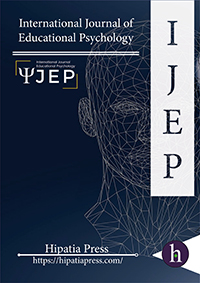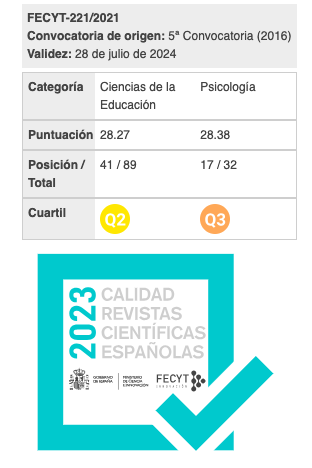Three Scales to Measure Burnout of Primary School Teachers: Empirical Evidence on their Adequacy
Keywords:
Downloads
Abstract
This study aimed at comparing the psychometric properties of three measures of burnout administered in 320 Greek primary school teachers, namely the Maslach Burnout Inventory (Maslach and Jackson 1982), the Burnout Measure (Pines and Aronson 1988) and the Copenhagen Burnout Inventory (Kristensen et al. 2005). Confirmatory factor analysis tested a three-factor solution for each inventory, consistent to the respective theory. Results yielded a reasonably good model fit for the MBI, and merely acceptable model fit for the BM and the CBI. Overall the findings suggest that the MBI is more appropriate instrument for assessing teachers' burnout compared to the MB and the CBI, which presented not so well-defined inner structure and highly correlated subscales.
Downloads
References
Boles, J. S., Dean, D. H., Ricks, J. M., Short, J. C., & Wang G. (2000). The dimensionality of the Maslach Burnout Inventory across small business owners and educators. Journal of Vocational Behavior, 56, 12-34.
Google Scholar CrossrefBorritz, M., & Kristensen, T. (1999a). Copenhagen Burnout Inventory (1st Ed.). Copenhagen, Denmark: National Institute of Occupational Health.
Google Scholar CrossrefBorritz, M., & Kristensen, T. (1999b). PUMA (Study on Personal Burnout, Work Burnout and Client Burnout). Copenhagen, Denmark: National Institute of Occupational Health.
Google Scholar CrossrefByrne, B. M. (1991). Burnout: Investigating the impact of background variables for elementary, intermediate, secondary, and university educators. Teaching and Teacher Education, 7 (2), 197–209.
Google Scholar CrossrefCampos, J. A. D. B., Zucoloto, M. L., Bonafé, F. S. S., Jordani, P. C., & Marôco, J. (2011). Reliability and validity of self reported burnout in college students: A cross randomized comparison of pencil-and-paper vs. online administration. Computers in Human Behavior, 27(5), 1875-1883.
Google Scholar CrossrefCorcoran S. M. (1986). Planning by expert and novice nurses in cases of varying complexity. Research in Nursing and Health, 9, 155-162.
Google Scholar CrossrefDemerouti, E., Bakker, A. B., Vardakou, I., & Kantas, A. (2003). The convergent validity of two burnout Instruments: A multitrait - multimethod analysis. European Journal of Psychological Assessment, 18, 296-307.
Google Scholar CrossrefDemirel, Y., Guler, N., Toktamis, A., Ozdemir, D. & Sezer, R.E. (2005) Burnout among High School Teachers in Turkey. Middle East Journal of Family Medicine, 3(3), 33-36.
Google Scholar CrossrefD’Souza, F., Egan, S. J., & Rees, C. S. (2011). The relationship between perfectionism, stress and burnout in clinical psychologists. Behavior Change, 28(1), 17-28.
Google Scholar CrossrefEnzmann, D., Schaufeli, W. B., Janssen, P., & Rozeman, A. (1998). Dimensionality and validity of the Burnout Measure. Journal of Occupational and Organizational Psychology, 71(4), 331-351.
Google Scholar CrossrefHakanen, J., Bakker, A.B., & Schaufeli, W.B. (2006). Burnout and work engagement among teachers. The Journal of School Psychology, 43, 495-513.
Google Scholar CrossrefKantas, A., &Vassilaki, E. (1997). Burnout in Greek teachers: Main findings and validity of the Maslach Burnout Inventory. Work and Stress, 11, 94-100.
Google Scholar CrossrefKlein, J., Grosse Frie, K., Blum, K., & Knesebeck, O. v. d. (2010) Burnout and perceived quality of care among German clinicians in surgery. International Journal for Quality in Health Care, 22, 525-530.
Google Scholar CrossrefKline, R. B. (2005). Principles and Practice of Structural Equation Modeling (2nd ed.). New York: Guilford Press.
Google Scholar CrossrefKokkinos, C. M. (2006). Factor structure and psychometric properties of the Maslach Burnout Inventory-Educators Survey among elementary and secondary teachers in Cyprus. Stress and Health, 22(1), 25-33.
Google Scholar CrossrefKristensen, T. S., Borritz, M., Villadsen, E., & Christensen, K. B. (2005). The Copenhagen Burnout Inventory: a new tool for the assessment of burnout. Work & Stress, 19(3), 192-207.
Google Scholar CrossrefKyriacou, C. (1987). Teacher stress and burnout: An international review. Educational Research, 29, 146–152.
Google Scholar CrossrefLin, L. P. & Lin, J. D. (2013). Job burnout amongst the institutional caregivers working with individuals with intellectual and developmental disabilities: Utilization of the Chinese version of the Copenhagen Burnout Inventory survey. Research in Autism Spectrum Disorders, 7, 777-784.
Google Scholar CrossrefMaslach, C. & Jackson, S. (1981). The Maslach Burnout Inventory. Palo Alto, CA: Consulting Psychologists Press, Inc.
Google Scholar CrossrefMaslach, C. & Jackson, S. E. (1986). Maslach Burnout Inventory Manual (2nd edition). Palo Alto: Consulting Psychologists Press.
Google Scholar CrossrefMaslach, C. & Schaufeli, W. B. (1993). Historical and conceptual development of burnout. In W. B. Schaufeli, C. Maslach & T. Marek (Eds.). Professional Burnout: Recent Developments in Theory and Research. Washington: Taylor and Francis.
Google Scholar CrossrefMaslach, C., Jackson, S.E., & Leiter, M.P. (1996). Maslach Burnout Inventory Manual (3rd edn.). Palo Alto, CA: Consulting Psychologists Press.
Google Scholar CrossrefMaslach, C., Schaufeli, W. B., & Leiter, M. P. (2001). Job burnout. Annual Review of Psychology, 52, 397-422.
Google Scholar CrossrefMearns, J., & Cain, J. E. (2003). Relationships between teachers’ occupational stress and their burnout and distress: Roles of coping and negative mood regulation expectancies. Anxiety, Stress, and Coping, 16, 71-82.
Google Scholar CrossrefMilfont, T. L., Denny, S., Ameratunga, S., Robinson, E., Merry, S. (2008). Burnout and wellbeing: testing the Copenhagen Burnout Inventory in New Zealand teachers. Social Indicators Research, 89(1), 169-177.
Google Scholar CrossrefOdagiri, Y., Shimomitsu, T., Ohya, Y., & Kristensen, T. S. (2004). Overcommitment and high effort are strongly associated with burnout among Japanese nurses. International Journal of Behavioral Medicine, 11(Suppl.), 214.
Google Scholar CrossrefPapastylianou, A., Kaila, M., & Polychronopoulos, Μ. (2009). Teachers’ Burnout, Depression, Role Ambiguity and Conflict. Social Psychology of Education, 12(3), 295-314.
Google Scholar CrossrefPines, A. (1994). The Palestinian Intifiada and Israelis' burnout. Journal of Cross-cultural Psychology, 25, 438-451.
Google Scholar CrossrefPines, A. M. (1996). Couple Burnout. New York: Routledge
Google Scholar CrossrefPines, A. M. (2002). Teacher burnout: A psychodynamic existential perspective. Teachers and Teaching: Theory and Practice, 8(2), 121-140.
Google Scholar CrossrefPines, A. M. (2004). Why Are Israelis Less Burned Out? European Psychologist, 9(2), 69-77.
Google Scholar CrossrefPines, A. M., Aronson, E., & Kafry, D. (1981). Burnout: From Tedium to Personal Growth. New York: Free Press.
Google Scholar CrossrefPines, A. M., & Aronson, E. (1988). Career Burnout: Causes and cures. New York: The Free Press.
Google Scholar CrossrefPlatsidou, M. (2010). Trait emotional intelligence of Greek special education teachers in relation to burnout and job satisfaction. School Psychology International, 31, 60-76.
Google Scholar CrossrefPlatsidou, M., & Agaliotis, I. (2008). Burnout, job satisfaction and instructional assignment related sources of stress in Greek special education teachers. International Journal of Disability, Development and Education, 55, 61-76.
Google Scholar CrossrefRay, E. B., & Miller, K. I. (1991). The influence of communication structure and social support on job stress and burnout. Management Communication Quarterly, 4, 506-527.
Google Scholar CrossrefSari, H. (2004). An analysis of burnout and job satisfaction among Turkish special school headmasters and teachers, and the factors affecting their burnout and job satisfaction. Educational Studies, 30(3), 291-306.
Google Scholar CrossrefSchaufeli, W. B & Dierendock., V. D., (1993). The construct validity of two burnout measures. Journal of Organizational Behaviour, 14(7), 631-637.
Google Scholar CrossrefSchaufeli, W. B., & Enzmann, D. (1998). The Burnout Campanion to Study and Practice: A Critical Analysis. London: Taylor and Francis.
Google Scholar CrossrefSchaufeli, W. B., Leiter, M. P., & Maslach, C. (2009). Burnout: 35 years of research and practice. Career Development International, 14(3), 204 – 220.
Google Scholar CrossrefSchreiber, J. B., Nora, A., Stage, F. K., Barlow, E. A. & King, J. (2006) Reporting Structural Equation Modeling and Confirmatory Factor Analysis Results: A Review. The Journal of Educational Research, 99(6), 323-337.
Google Scholar CrossrefSchutte, N., Toppinen, S., Kalimo, R. & Schaufeli, W. B. (2000). The factorial validity of the Maslach Burnout Inventory - General Survey (MBI-GS) across occupational groups and nations. Journal of Occupational and Organizational Psychology, 73(1), 53-66.
Google Scholar CrossrefShirom, A, & Ezrachi, Y. (2003). On the discriminant validity of burnout, depression and anxiety: A re-examination of burnout measure. Anxiety, Stress & Coping: An International Journal, 16(1), 83-97.
Google Scholar CrossrefShirom, A. (2005). Reflections on the study of burnout. Work & Stress, 19, 263–270.
Google Scholar CrossrefTaris, T. W., Schaufeli, W. B, De Boer, E. M., Schreurs, P. J. G. & Caljé, D. G. (2000). On billijkheid in de arbeidssituatie, gezondheidenziekteverzuim. Hoe ziek is de calculerendeleraar? [Inequity at work, health and absenteeism. How ill is the calculative teacher?] Gedrag & Gezondheid, 28, 123-137.
Google Scholar CrossrefTaris, T. W., Le Blanc, P., Schaufeli, W. B. & Schreurs, P. J. G. (2005). Are there relationships between the dimensions of the Maslach Burnout Inventory? A review and two longitudinal tests. Work & Stress, 19, 256-262.
Google Scholar CrossrefWeisberg, J., Sagie, A. (1999). Teachers’ physical, mental, emotional burnout: impact on intention to quit. The Journal of Psychology, 133(3), 333-339.
Google Scholar CrossrefWinwood, P., & Winefield, A. H. (2004). Comparing two measures of burnout among dentists in Australia. International Journal of Stress Management, 11, 282- 289.
Google Scholar CrossrefDownloads
Published
Almetric
Dimensions
How to Cite
Issue
Section
License
All articles are published under Creative Commons copyright (CC BY). Authors hold the copyright and retain publishing rights without restrictions, but authors allow anyone to download, reuse, reprint, modify, distribute, and/or copy articles as the original source is cited.
















